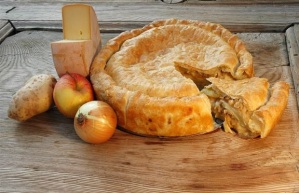I posted this originally in 2012, and wanted to share it with those new to the blog! I’ll be making this tonight as a dessert to Swiss cheese fondue; despite the cream layer, it will make a light and refreshing contrast to the heavier main meal. Over a decade ago, I got this recipe from a Swiss friend; I’ve made it dozens of times, and it always gets rave reviews and requests for the recipe! Unlike other tiramisu, this has no raw eggs, or coffee.

Lady Fingers Cookies
Swiss Apple Tiramisu
750 gr. apples
Peel them, chop into large chunks, and blitz them with a chopper (or knife if you’re a purist) into a coarse apple puree. Add:
1 Tbs. vanilla sugar
½ lemon’s juice
1 C. apple juice
a dash of Amaretto or almond extract
Mix it all together into an apple sauce. Next, in a separate bowl, mix the cream layer:
500 gr. mascarpone
5 dl. whipped cream
2 Tbs. apple schnapps (Calvados)
Beat til foamy. You’ll also need:
3 pkgs. Lady Finger cookies (approx. 18 per 2 layers = 36)
In a casserole dish, layer as follows: A bit of applesauce, then rows of biscuits, and whipped topping; repeat once more.
Make this at least an hour before serving, and chill it until time to serve. I stab toothpicks around the edge and a few down the centre to keep the plastic foil from touching a nicely-smoothed surface.













